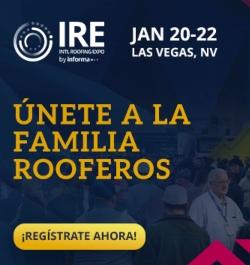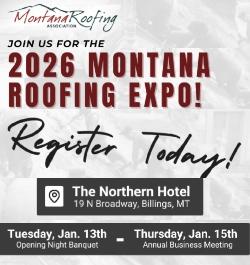Rick Morrow & Randy O’Shea – The Importance of Ventilation and Choosing the Right Vent - PODCAST TRANSCRIPT
October 25, 2023 at 12:00 p.m.Editor's note: The following is the transcript of a live interview with Rick Morrow and Randy O'Shea from FlashCo. You can read the interview below or listen to the podcast.
Intro: Welcome to Roofing Road Trips with Heidi. Explore the roofing industry through the eyes of a long-term professional within the trade. Listen for insights, interviews, and exciting news in the roofing industry today.
Heidi J. Ellsworth: Hello, and welcome to another Roofing Road Trips from RoofersCoffeeShop. This is Heidi Ellsworth, and today we're going to be talking about the most important thing in roofing, and that is ventilation. Ventilations, the importance of it, choosing the right vent. We asked the experts from FlashCo to come and join us, Rick Morrow and Randy O'Shea. Gentlemen, welcome to the podcast.
Rick Morrow: Thank you, Heidi.
Randy O’Shea: Hey, Heidi. Thank you.
Heidi J. Ellsworth: Thank you. I'm just so glad to have both of you here, and I'd love to start out with some introductions. So Rick, if you could start, introduce yourself, tell us a little bit about your company.
Rick Morrow: Sure. Rick Morrow, we're FlashCo manufacturing and I'm the... I'll just go a little bit off-topic here. I'm the youngest of seven children, I have a dream wife. I've been working for FlashCo about 20 years now. So far it's been a pretty good ride, ups and downs. Truth be told, I am Greg's brother, so there is that. And that's about it for me.
Heidi J. Ellsworth: Randy, introduce yourself and then tell us a little bit even more about FlashCo.
Randy O’Shea: I'm Randy. I'm our Customer Service Manager for the company. I've been with us a little over 10 years, going on 10 and a half years. I've worked in many aspects of the company and love it and love our product. FlashCo did start in the year 2000 in northern California, and now we have nine facilities across the entire country, newest one being in Pennsylvania, and I am residing in our Fort Worth Texas facility now. FlashCo started making lead accessories and sheet metal type stuff, and now our identity is mostly simplified products, so what we do is save the contractor time. All of our products are designed with labor in mind and can't wait to talk more about it.
Heidi J. Ellsworth: I love it. I love it. Prefabrication, what you've all done, you have saved so much time on the roof and the contractors, I've watched you revolutionize the industry. Rick, let's talk, I'm not sure if everybody always gets that connection between your prefab items, even though I know a lot of them are vents, but there's also, obviously, you have a huge category of products. Let's go over, if you wouldn't mind starting us out, and then we'll bring Randy in, talking about the vent as your biggest product category in your range of options.
Rick Morrow: Yeah, we do have quite a range of options when it comes to venting for sure, Heidi. We have vents that are forced air exhaust, like your bathroom, your kitchen, your dryers. We have gravity vents, square top vents, T-top vents, breather vents. In Northern California, we even offer a B-vent, which is specific to that market, so that's for heated exhaust. And the most uniquely I would say is the Easy Flapper, which is selling like hotcakes up in the Pacific Northwest.
Heidi J. Ellsworth: Well, that's where I'm from, Oregon. So I'm glad to hear that we need ventilation like nobody's business on our buildings up here. I know. Well, Randy, with customer service, you are talking to contractors all the time, what are you hearing from them about your wide range of ventilation products?
Randy O’Shea: I think that more recently wall vents are starting to come up, things like that, that we get a lot of questions on. More of our newer products. There's the staples in the industry, the things that everyone knows about, like the B-vents like Rick was talking about, and fan exhaust. But on a lot of these re-roofing projects or even new construction, there's a lot of specifications for types of vents that aren't necessarily for single-ply roofs, old built up specs and things like that. I think that more like the wall vents and like Rick was talking about the Easy Flapper, the breather vents, more of these newer offerings are the types of questions that we get most for sure.
Heidi J. Ellsworth: Let's dive into that a little bit. I wanted to talk through some of those, and one of the first ones I was interested in was the gravity vent, or gravity vents, I should say. They seem to be gaining a lot of popularity, maybe you can talk a little bit about that, Rick, starting out on just what that is.
Rick Morrow: Well, gravity vents are great for reducing indoor heat, and they also help improve the indoor air quality as well. And they do that by offering just a near constant air exchange with the fresh outdoor air. It's really a good way to keep big power plants, big factories, even temperatures with fresh air. They are moving a lot in the warmer climates.
Heidi J. Ellsworth: As you're looking at that, I know, Randy, you just talked about breather vents. Where does that fit in?
Randy O’Shea: The breather vents are used... Rick can probably explain this better. I saw he had something written up and he touched on some parts that-
Rick Morrow: Well, being from the northwest, I have to know a little bit about it. The breath events, their main purpose is to remove moisture from underneath the membranes, and it also will allow for heat to come out too on those hot days. It also includes removing stale air from the attic space and it really prevents damage to the roof. I'm sure a lot of roofers has torn off roofs and seen dry rod, if you will and that started out with a little bit of moisture, and that just started the scale or tipping the scales of the whole roof substrate needed to be replaced.
Heidi J. Ellsworth: I've seen this, Rick, so much. Just having grown up, you're from the Pacific Northwest also, right?
Rick Morrow: Yes.
Heidi J. Ellsworth: When you look at the regionality of venting and the different areas, maybe just talk a little bit about that, the importance of going back between the breather vents, the gravity. I know we're going to get to the flapper, which I'm really excited about, but I think I just want to follow up on that one point of how important it's to understand your climate.
Rick Morrow: Definitely. It's pretty unique up here, especially in the residential markets for venting. There's an item we call the RVO, appears essentially what the square top is for the single-ply world. And I don't think you can go buy many houses and not see an RVO on a roof. It's just to get the moisture out, keep it from building up and let the heat out when it's hot, big changes in temperatures in certain areas of the world, and that creates condensation moisture and whatnot.
Heidi J. Ellsworth: Take it from there, and let's talk about this, on flash vent, Easy Flapper, exhaust vent. This is a brand new product, you guys... I mean, we're talking about it a lot. Can you give us an overview, Rick, on it?
Rick Morrow: Sure. It's available for both TPO and PVC. We can also solder it up and it could be up for built up roofing as well. It comes standard in four different sizes. That's four, six, and eight. Essentially, it's a positive connection to any exhaust fan, as I mentioned earlier, like bathroom, dryer vents, kitchen vents and dryers. It's really just a great way to ensure that the moisture gets out of the bathrooms and anything you're cooking, the odors in the steam gets outside of the house.
Heidi J. Ellsworth: And talk about how that vent... There's a flap on the top and talk about just the overall vent, how it looks and how it's functioning.
Rick Morrow: There's a lot of things coming out on certain roofs, especially on the flat roof's commercial. We don't want air coming down through other vents, so that flapper prevents air from other things on the roofs, getting down into where we live. It helps, like I said earlier, the moisture from the attic come out as well... Or keeps the moisture out of that attic, excuse me, by that positive connection I spoke about. If we have our bathrooms exhausting up into the attic space, that doesn't do anybody any good.
Heidi J. Ellsworth: No. This is going to help with insects, and obviously moisture and rain?
Rick Morrow: Oh yeah.
Heidi J. Ellsworth: Considering how much rain we have here. Randy, from a customer service standpoint, what are you hearing back from the contractors about Easy Flapper?
Randy O’Shea: Again, a lot of the old specs are for different types of roofs. So I had... Actually, just a few weeks ago, I had a homeowner give us a call and he was wondering if a curb needed to be built for our Easy Flapper since a portion of his residential roof that they were installing this Easy Flapper on was indeed a low slope, essentially like a flat portion. And I was like, "Man, I don't think so." And he was saying, "I'm working with a general contractor who's saying, 'No for these types of ventilation on these roofs, you have to build a curb to keep it up off the roof deck high enough.'" And I said, "Well, I think with FlashCo's offering, because it meets the minimum height requirement for commercial roofs, you don't have to." So I indeed learned in that conversation that that's a pretty important piece of it too that makes the product good as it already is, but it meets that minimum height requirement. And we were able to make where he didn't have to put a $2,000 curb up there, he said it was going to cost.
Heidi J. Ellsworth: Geez, that's a huge savings. And the fact that it's already prefabbed, it's all put together and ready to go.
Randy O’Shea: He was asking if he could install it. I said, "I wouldn't recommend it. I'd probably call a roofing contractor to install that." You don't want to go and buy four of these vents to get one right. But it comes with... His was a PVC project, it comes with a PVC or TPO boot on it, so it's ready to weld.
Rick Morrow: And really what does it for the Easy Flapper for most people, especially maintenance guys, that top comes off and it's easy to clean out, especially those dryer vents, which we know are a big fire hazard.
Heidi J. Ellsworth: Well, and Rick talk a little bit too, I know this is both commercial and residential, because talking about both. Absolutely, and I would think when you're talking about multifamily apartment buildings, multiple tenants, these type of flashings become even more important
Rick Morrow: With all that going on, other people's exhausts coming through other people's living spaces, essentially in their attics and whatnot, these positive connections need to be made for each and every bathroom and kitchen fan. And without them, it would be just decaying the building from the inside out. I wish I could show you some pictures, maybe Rob can provide some of those.
Heidi J. Ellsworth: We can, and everyone can go to your directory, the FlashCo directory and see the pictures. And I believe we're having some on video too, so we'll be able to show that. Anybody listening to this podcast, check out the directory because you'll be able to find all these different vents that are coming out and that FlashCo offers. I have a little question on... Not a little bit, a question on trending. You all, Rick and Randy, you see it across the country, and we talked about... I know you first started out, Rick, and you were talking a little bit about the gravity vents and how they're to get the inside out that's more manufacturing and commercial I'm guessing. But what are some of the trends that you're seeing in ventilation that is really important that roofing contractors should be aware of?
Rick Morrow: Primarily the breather vents, I would say. It used to be... Well, hardly anybody sold them, and I'm telling you, we're selling thousands and thousands of those now. They've taken off. And that is because of that moisture problem, especially if you're re-roofing, and there's a little bit of moisture underneath there type of weather out here. So these breather events have become commonplace on the single-ply roofs up in the northwest, and that's spreading across the country too for that condensation reason.
Heidi J. Ellsworth: You're hearing about this, especially I would think also with what's going on with coatings and so much of roof restorations out there too, that ventilation's becoming even more important. We're seeing some of that as it's coming through as people are doing all the moisture tests and checking things out and just restoring it, but then they have to make sure that, like you said, they have all the connections right, and everything is working properly and not too old. Randy, what are trends that you're hearing on the phones as you're talking to customers?
Randy O’Shea: I'd say the breather vents, like Rick said, are a big trend. Those are selling like hotcakes over in markets like Florida especially. Again, like I said in the beginning, the wall vents, there hasn't been a great solution for that. I actually met with a contractor in San Jose, California, shout out South Valley Roofing. I don't know if they listened to this, but-
Heidi J. Ellsworth: [inaudible 00:14:32].
Randy O’Shea: There's Jim. He showed me what he was doing. He took me up on a roof and he showed me. What they were doing is they were using the cable that they purchased from Home Depot probably costs $30 or so. They were painted white, which is great. And then in their shop, they were installing TPO coated galvanized steel to there, riveting it on and then would take it out to the field and they would weld the membrane onto that part. And I said, "We can do this for you in-house." And so we took it and we now have started making a different type of the base vent itself, but it's a Louvre vent, so it's got the Louvres, it's just like any old gable vent you see on a house, but they're square or rectangular in size to fit between 12 inch, 16 inch or 24 inch on center studs. I think actually our standards are only 12 and 16.
And it's provided an excellent solution for venting parapet walls, things of that [inaudible 00:15:34] more and more. That's more of a re-roof thing I would imagine. But there's big old parapet walls. We also have one that can be intended for a 45 degree brace wall as well, having seen it trending, but I think it should. That's our eyebrow wall vent. And then out in the California markets especially, or the California market, I say markets because it's such a long state, but the gravity vent. As far as I know, FlashCo made the first larger single-ply gravity vent that's ready to install. Those are standard in 12 by 12, 18 by 18 and 24 by 24. And a lot of these large buildings, our 24 by 24 has quite a bit of square inches of net free air, so it takes a lot less of them to achieve the ventilation you need for the attic space. Those have taken off within the last years or so, pretty well as well, mainly due to the size. Now the RVOs are great, but there's only 38 square inches of airflow, so instead of installing a hundred of those, you can install 10 or so of our gravity vents.
Heidi J. Ellsworth: It just wouldn't be a FlashCo podcast if we didn't talk a little bit about the time that you're saving. It really comes back to, randy, what you were saying about the contractors who are working with Home Depot, but then once they worked with you, it comes prefabbed, it's ready, everything's the right way it needs to be. Talk a little bit about the importance of that time savings for contractors, and what it's really doing to help with the labor shortage and their productivity.
Randy O’Shea: Time's everything. Time is money. That's a saying everybody knows. And I'm not joking or just saying this because I worked for this company. Our products save the Contractor money. I do think that, and it's a timing thing. What FlashCo has thrived in is our service, that's why we have nine facilities and nine major areas. We have our own delivery trucks that deliver to distributors. Most of them will hopefully have this on their shelves. And speed and time, that's the name of the game and that's what we've built our business on.
Rick Morrow: That's right.
Randy O’Shea: Not only our products, but our service.
Heidi J. Ellsworth: I love it. Rick, talk just a little bit more to that also in the custom, the ability to really, for contractors to get what they need by working with you on custom orders.
Randy O’Shea: Thanks. Randy was really good about doing the custom orders. He was in outside sales for quite some time, that's why he got to know Jim and all the other roofers in the Bay Area quite well. And boy, we just liked those challenges. When somebody can draw something up, we want to make it for them. And as hard as it is at times to look at their drawing on a napkin and try to figure it out, we have an in-house CAD guy now, and he's able to turn out drawings for us really within hours. We get the roof to sign off on it and it's done.
Heidi J. Ellsworth: That's great. Let's talk a little bit about that process. For all the roofing contractors out there right now, who are listening to this saying, "I need to get some of those vents." That Gravity vent, that breather vent, for sure the Easy Flapper exhaust vent. What's the process for contractors to buy through distribution? How do they get ahold of you directly for custom jobs? How does that work? Randy, maybe you can walk us through it.
Randy O’Shea: FlashCo sells through roofing distribution, but we love working with the roofing contractor directly and we encourage it. We can learn a lot together and come up with a better solution in that way. If there's anything you can think of, if there's something you're looking at and going, "Oh my gosh, this is going to take me three hours to make this or that to figure it out." Give us a try. We may be able to come up with an affordable solution, when you consider your time and the cost of the product to get over all sorts of stuff. Odd drains, odd ventilation, how do I wrap this 60 inch wide smoke stack or whatever that thing was we did in the northeast [inaudible 00:20:13]? I think it's worth a shot. What's the worst that could happen?
Heidi J. Ellsworth: And Rick, as we look into 2024, you are all always, FlashCo is always innovating, and we know you have the new safety line out, all the vents, any sneak peeks you can give us going into 2024 on what people should be watching for from FlashCo?
Randy O’Shea: I don't know if I'm ready to pull back the curtain yet. So stay tuned. We expect the HLL, the Horizontal Lifeline, to do real well for us. We are giving training on a regular basis to installers and we are showing it the regional shows as well as the national and international shows. Stay tuned on more to come from FlashCo. We have worked up our sleeve.
Heidi J. Ellsworth: I love it. And this is the place, you'll see it right here on RoofersCoffeeShop because everything we talked about today is on the directory. For you to get started to really find out where you can buy it through distribution, how you can get ahold of Randy, and customer service, and all of the team there, you can get all of that information right off the directory on RoofersCoffeeShop. Rick, Randy, thank you so much for your time today, this has been very informational.
Rick Morrow: Thanks, Heidi.
Randy O’Shea: Thank you, Heidi.
Heidi J. Ellsworth: Thank you. And thank you so much. We will be staying tuned for that curtain unveiling, probably coming in the beginning of next year. You might want to check IRE everybody, make sure you put FlashCo on your list to visit. And I also want to say thank you to everyone for listening today. This is the kind of information that we want to bring constantly that helps you. If you have more questions on gravity vents, breather vents, or the easy flap, or exhaust vent, like I said, please visit the directory for FlashCo on RoofersCoffeeShop, also on Metal Coffee Shop and Coatings Coffee Shop. We also want you to hear all of our podcasts, which can be found under the RLW navigation, under podcasts and Roofing Road Trips, or on your favorite podcast channel. Be sure to subscribe and get those notifications so you don't miss a single episode. Thank you so much, and we will be seeing you next time on Roofing Road Trips.
Outro: Make sure to subscribe to our channel and leave a review. Thanks for listening. This has been Roofing Road Trips with Heidi from the rooferscoffeeshop.com.























Comments
Leave a Reply
Have an account? Login to leave a comment!
Sign In